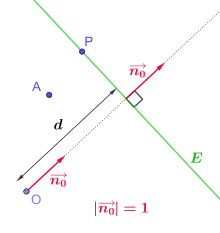Hesse normal form
The Hesse normal form named after Otto Hesse, is an equation used in analytic geometry, and describes a line in or a plane in Euclidean space or a hyperplane in higher dimensions.[1][2] It is primarily used for calculating distances (see point-plane distance and point-line distance).

It is written in vector notation as
The dot indicates the scalar product or dot product. Vector points from the origin of the coordinate system, O, to any point P that lies precisely in plane or on line E. The vector represents the unit normal vector of plane or line E. The distance is the shortest distance from the origin O to the plane or line.
Derivation/Calculation from the normal form
Note: For simplicity, the following derivation discusses the 3D case. However, it is also applicable in 2D.
In the normal form,
a plane is given by a normal vector as well as an arbitrary position vector of a point . The direction of is chosen to satisfy the following inequality
By dividing the normal vector by its magnitude , we obtain the unit (or normalized) normal vector
and the above equation can be rewritten as
Substituting
we obtain the Hesse normal form

In this diagram, d is the distance from the origin. Because holds for every point in the plane, it is also true at point Q (the point where the vector from the origin meets the plane E), with , per the definition of the Scalar product
The magnitude of is the shortest distance from the origin to the plane.
References
- Bôcher, Maxime (1915), Plane Analytic Geometry: With Introductory Chapters on the Differential Calculus, H. Holt, p. 44.
- John Vince: Geometry for Computer Graphics. Springer, 2005, ISBN 9781852338343, pp. 42, 58, 135, 273